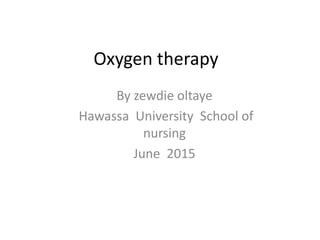Oxygen therapy involves administering oxygen at concentrations greater than in the atmosphere to treat hypoxemia. It is used for conditions like respiratory failure, heart failure, shock, and anemia. Oxygen can be delivered via nasal cannula, face masks, venturi masks, or mechanical ventilation. Proper monitoring and precautions are needed due safety risks like fire and oxygen toxicity. Oxygen therapy aims to improve tissue oxygenation and decrease workload on the heart and lungs.
























































































































